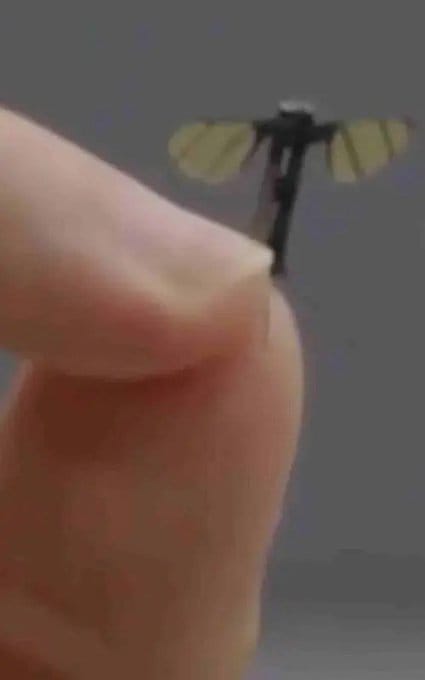China's Mosquito-Sized Military Drones: A New Era of Warfare Technology

The Dawn of Nano-Warfare
In the ever-evolving landscape of military technology, China has unveiled what may be one of the most revolutionary developments in modern warfare: mosquito-sized drones capable of covert reconnaissance and surveillance operations. These nano-scale unmanned aerial vehicles, measuring just 1.3 centimeters across, represent a paradigm shift in military intelligence gathering and battlefield operations.
The implications of this technology extend far beyond conventional warfare, touching on issues of privacy, security, and the fundamental nature of conflict in the 21st century. As nations around the world grapple with the potential of artificial intelligence, quantum computing, and autonomous systems, China's nano-drone technology emerges as a stark reminder that the future of warfare may be smaller, more pervasive, and more difficult to detect than ever before.
The Technology Behind the Buzz
Design and Specifications
Developed by researchers at China's National University of Defense Technology (NUDT), the mosquito-sized drone represents a masterpiece of miniaturization. At just 1.3 centimeters across, the device is barely larger than a human fingernail and weighs less than 0.2 grams. Its design mimics nature's own engineering, featuring two translucent wings and three razor-thin legs that make it virtually indistinguishable from an actual insect.
The drone's biomimetic design is not merely aesthetic—it serves crucial functional purposes. The insect-like appearance allows the device to operate in plain sight without raising suspicion, while its diminutive size enables it to access confined spaces where larger surveillance equipment would be impossible to deploy. The wings provide both lift and propulsion, while the legs may serve as landing gear for perching on surfaces during extended surveillance operations.
Technical Capabilities
Despite its microscopic size, the nano-drone packs impressive technological capabilities. The device is equipped with ultra-miniature cameras and microphones capable of capturing high-quality images, audio recordings, and electronic signals. This multi-modal sensing capability makes it an ideal platform for comprehensive intelligence gathering in both military and civilian contexts.
The drone can be controlled via smartphone, suggesting a user-friendly interface that could enable rapid deployment by field operatives with minimal training. This accessibility factor is crucial for military applications where ease of use can mean the difference between mission success and failure.
Perhaps most importantly, the drone's ultra-small size allows it to evade detection by conventional radar systems. Traditional radar technology is designed to detect objects with significant electromagnetic signatures, making these nano-drones effectively invisible to most current detection methods.
Power and Limitations
The laws of physics present significant challenges for nano-scale robotics, and the mosquito drone is no exception. Battery life represents the most significant limitation, as the device's tiny form factor severely restricts the amount of energy storage possible. This necessitates frequent recharging and limits operational duration, making the drone more suitable for short-duration missions rather than extended surveillance operations.
Communication range presents another constraint. The operator must remain relatively close to maintain signal connectivity, which could expose personnel to risk in hostile environments. This limitation suggests that the technology is best suited for targeted intelligence gathering rather than broad-area surveillance.
Military Applications and Strategic Implications
Reconnaissance and Intelligence Gathering
The primary military application for nano-drones lies in intelligence, surveillance, and reconnaissance (ISR) operations. These devices can access areas that would be impossible or extremely dangerous for human operatives or larger surveillance equipment. Indoor spaces, underground facilities, and heavily fortified installations all become accessible to these diminutive spies.
The ability to conduct covert surveillance in urban environments represents a particular advantage. In modern conflicts, which increasingly take place in densely populated areas, the ability to gather intelligence without civilian casualties or international incident becomes invaluable. A mosquito-sized drone can monitor enemy movements, record conversations, and map facility layouts without the risk associated with human intelligence operations.
Special Operations Support
Military special operations units could benefit significantly from nano-drone technology. These forces often operate in environments where traditional surveillance methods are impractical or too risky. The ability to deploy multiple nano-drones for reconnaissance before engaging targets could provide crucial tactical advantages and reduce operational risks.
The smartphone-controlled interface makes the technology accessible to field operatives without requiring extensive technical training. This democratization of advanced surveillance capabilities could transform how special operations are planned and executed.
Psychological Warfare Potential
Beyond their direct intelligence-gathering capabilities, nano-drones could serve as tools of psychological warfare. The knowledge that adversaries possess surveillance technology so small and pervasive that it's virtually undetectable could create significant psychological pressure on enemy forces and civilian populations.
This psychological dimension adds a new layer to the concept of information warfare, where the mere possibility of surveillance can influence behavior and decision-making processes.
China's Broader Military Technology Ecosystem
Drone Mothership Technology
The mosquito drone represents just one component of China's comprehensive drone warfare strategy. The People's Liberation Army has also developed massive drone motherships capable of transporting 100 UAVs over distances of 4,000 miles. These 11-ton behemoths, scheduled to join China's arsenal by mid-2025, represent the opposite end of the size spectrum from nano-drones.
The combination of large-scale drone carriers and nano-scale surveillance platforms suggests a multi-layered approach to unmanned warfare. Large drones can provide heavy lifting and extended range capabilities, while nano-drones offer stealth and access to restricted areas.
Artillery-Launched Drones
China has also developed drones that can be fired from 155mm artillery shells, enabling rapid deployment to locations over six miles away. This capability provides tactical commanders with the ability to deploy surveillance assets in near real-time, potentially changing the dynamics of battlefield intelligence gathering.
The integration of drone technology with traditional artillery systems represents an innovative approach to force multiplication, where conventional weapons platforms gain enhanced capabilities through the addition of autonomous systems.
AI-Powered Swarm Systems
Perhaps most significantly, China is developing AI-powered drone swarms that can operate autonomously in coordinated attacks. These systems represent a fundamental shift toward autonomous warfare, where human operators provide high-level objectives while AI systems handle tactical execution.
The combination of nano-drones for reconnaissance and AI-powered swarms for attack creates a potentially devastating military capability. Nano-drones could identify and track targets, while larger autonomous systems engage them based on AI-driven decision-making processes.
Advanced Supporting Technologies
Quantum Computing and Communication
China's development of quantum computing technology, including the recent unveiling of the Zuchongzhi 3.0 105-qubit quantum processor, provides the computational foundation for advanced autonomous systems. Quantum computing could enable nano-drones to process vast amounts of sensor data in real-time, improving their effectiveness and reducing the need for human oversight.
Quantum communication systems could also provide secure, unbreakable communication channels for drone operations, addressing one of the key vulnerabilities of current remote-controlled systems.
Hypersonic Weapons Integration
China's hypersonic weapons program, which includes missiles capable of traveling at Mach 20, creates new challenges for defense systems worldwide. The integration of nano-drone reconnaissance with hypersonic weapons could create a devastating combination where targets are identified and engaged faster than current defense systems can respond.
The development of microwave-optoelectronic fusion radar systems capable of tracking hypersonic missiles suggests that China is simultaneously developing both offensive and defensive capabilities in this domain.
Anti-Stealth and Detection Systems
China's advancement in anti-stealth radar technology and quantum radar systems provides the infrastructure necessary to support advanced drone operations. These systems can detect and track enemy stealth aircraft while remaining invisible to conventional detection methods themselves.
The combination of advanced detection capabilities with nano-scale surveillance platforms creates a comprehensive intelligence network that could provide unprecedented situational awareness on future battlefields.
Global Implications and Responses
The Arms Race Dynamic
China's nano-drone technology is likely to accelerate a global arms race in autonomous systems. Other nations will feel compelled to develop similar capabilities, both for offensive operations and defensive countermeasures. This dynamic could lead to rapid advancement in the field but also increased global instability.
The United States has already developed competing technologies, including the Teledyne Black Hornet 4 and Vantage Robotics Trace systems. However, these platforms are measured in inches rather than centimeters, suggesting that China may have achieved a significant technological advantage in miniaturization.
Ethical and Legal Considerations
The development of nano-surveillance technology raises significant ethical and legal questions. The ability to conduct surveillance that is virtually undetectable challenges existing frameworks for privacy protection and international law. The potential for abuse in both military and civilian contexts is substantial.
International agreements governing the use of autonomous weapons systems may need to be updated to address nano-scale platforms that blur the lines between surveillance and combat systems.
Defensive Countermeasures
The emergence of nano-drone technology will likely drive development of new defensive systems specifically designed to detect and neutralize these threats. This could include advanced radar systems, electromagnetic warfare capabilities, and even biological countermeasures that mimic natural predator-prey relationships.
The challenge for defensive systems is detecting and engaging targets that are specifically designed to be invisible to current detection methods. This may require entirely new approaches to surveillance and security.
Future Developments and Timeline
Near-Term Expectations (2025-2026)
Based on current development timelines, nano-drones are expected to enter service with the People's Liberation Army as early as 2026. Initial deployments will likely focus on intelligence gathering and reconnaissance operations, with combat applications following as the technology matures.
The integration of nano-drones with existing military systems will require significant training and doctrine development. Military forces will need to adapt their operational procedures to incorporate these new capabilities effectively.
Medium-Term Projections (2027-2030)
As the technology matures, we can expect to see improved battery life, enhanced communication systems, and more sophisticated AI capabilities. The development of autonomous swarms of nano-drones could provide unprecedented surveillance coverage and intelligence gathering capabilities.
The integration of nano-drones with other emerging technologies, such as quantum computing and advanced materials, could create capabilities that are difficult to imagine with current technology.
Long-Term Implications (2030+)
The long-term implications of nano-drone technology extend far beyond military applications. These systems could transform law enforcement, border security, environmental monitoring, and even civilian surveillance. The potential for both beneficial and harmful applications is enormous.
The development of nano-manufacturing capabilities could enable the mass production of these devices at extremely low costs, potentially democratizing access to advanced surveillance technology.
Conclusion: The Buzzing Future of Warfare
China's mosquito-sized military drones represent more than just a technological achievement—they signal a fundamental shift in the nature of warfare and surveillance. These devices embody the convergence of multiple advanced technologies, including miniaturization, artificial intelligence, quantum computing, and autonomous systems.
The implications extend far beyond the battlefield. In a world where surveillance technology can be made invisible to the naked eye and virtually undetectable by current security systems, the concepts of privacy, security, and sovereignty must be reconsidered. The ability to deploy pervasive surveillance networks using technology that resembles common insects challenges our basic assumptions about personal and national security.
As nations around the world respond to this technological challenge, we are likely to see rapid advancement in both offensive and defensive capabilities. The development of countermeasures, ethical frameworks, and international agreements will be crucial to managing the risks associated with this technology.
The mosquito may be one of nature's most persistent and pervasive creatures, but China's artificial version may prove to be even more formidable. As we stand on the threshold of an age where the line between natural and artificial, between surveillance and combat, becomes increasingly blurred, the lessons learned from China's nano-drone program will likely shape the future of warfare for generations to come.
The buzz of a mosquito may never sound the same again. In an age where any small flying creature could potentially be a sophisticated surveillance platform, the very nature of privacy and security is being redefined. The question is not whether other nations will develop similar capabilities, but how quickly they can adapt to a world where the smallest threats may prove to be the most dangerous.
As China continues to expand its robotics capabilities—with over 450,000 individual robotics firms and drones set to dominate production by 2028—the mosquito-sized drone represents just the beginning of a new era in military technology. The future of warfare may indeed be smaller, smarter, and more pervasive than ever before, buzzing quietly in the background while reshaping the very foundations of national security and international relations.





